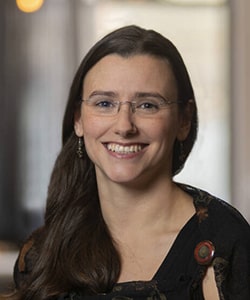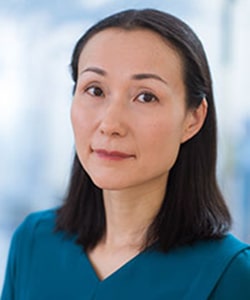Fall 2023
 October 13, 2023: Laurence Perreault-Levasseur (Université de Montréal / Mila)
October 13, 2023: Laurence Perreault-Levasseur (Université de Montréal / Mila)
Title: Data-Driven Strong Gravitational Lensing Analysis in the Era of Large Sky Surveys
[Perreault-Levasseur Talk Recording] [Perreault-Levasseur Talk Slides]
Abstract: Despite the remarkable success of the standard model of cosmology, the lambda CDM model, at predicting the observed structure of the universe over many scales, very little is known about the fundamental nature of its principal constituents: dark matter and dark energy. In the coming years, new surveys and telescopes will provide an opportunity to probe these unknown components. Strong gravitational lensing is emerging as one of the most promising probes of the nature of dark matter, as it can, in principle, measure its clustering properties on sub-galactic scales. The unprecedented volumes of data that will be produced by upcoming surveys like LSST, however, will render traditional analysis methods entirely impractical. In recent years, machine learning has been transforming many aspects of the computational methods we use in astrophysics and cosmology. I will share our recent work in developing machine learning tools for the analysis of strongly lensed systems.
Bio: Laurence Perreault-Levasseur is the Canada Research Chair in Computational Cosmology and in Artificial Intelligence. She is an assistant professor at the University of Montréal and an Associate Member of Mila, where she conducts research in the development and application of machine learning methods to cosmology. She is also a Visiting Scholar at the Flatiron Institute in New York City. Prior to that, she was a Flatiron research fellow at the Center for Computational Astrophysics in the Flatiron Institute and a KIPAC postdoctoral fellow at Stanford University. Laurence completed her PhD degree at the University of Cambridge, where she worked on applications of open effective field theory methods to the formalism of inflation.
 October 27, 2023: Michael Wehner (Lawrence Berkeley National Laboratory)
October 27, 2023: Michael Wehner (Lawrence Berkeley National Laboratory)
Title: Extreme Weather Impact Attribution, Environmental Justice and Loss & Damages
[Wehner Talk Recording] [Wehner Talk Slides]
Abstract: Reporting the effect of global warming on certain classes of individual extreme weather events has become relatively routine. Research is now turning to quantifying the resulting effects on the impacts of these extreme weather events. I will use Hurricane Harvey and its exceptional flood of the greater Houston area in 2017 to demonstrate an “end to end” attribution. The human induced warming of the Gulf of Mexico increased the storm’s precipitation causing an increase in the flooded area that in turn caused an increase in the number of homes flooded. A disproportionate number of these flooded homes were in low income Hispanic neighborhoods. This example will then be used to motivate how climate scientists can inform the recently approved UNFCCC Loss and Damage fund established to aid nations that are “particularly vulnerable” to the impacts of climate change.
Bio: Michael F. Wehner is a senior staff scientist in the Applied Mathematics and Computational Research Division at the Lawrence Berkeley National Laboratory. Dr. Wehner’s current research concerns the behavior of extreme weather events in a changing climate, especially heat waves, intense precipitation, drought and tropical cyclones. Before joining the Berkeley Lab in 2002, Wehner was an analyst at the Lawrence Livermore National Laboratory in the Program for Climate Modeling Diagnosis and Intercomparison.
He is the author or co-author of over 230 scientific papers and reports. He was a lead author for both the 2013 Fifth and 2021 Sixth Assessment Report of the Intergovernmental Panel on Climate Change and the 2nd, 3rd and 4th and upcoming 5th US National Assessments on climate change. Dr. Wehner earned his master’s degree and Ph.D. in nuclear engineering from the University of Wisconsin-Madison, and his bachelor’s degree in Physics from the University of Delaware.
 November 10, 2023: Michael Kagan (SLAC National Accelerator Laboratory)
November 10, 2023: Michael Kagan (SLAC National Accelerator Laboratory)
Title: Using gradients to get more out of High Energy Physics
[Kagan Talk Recording] [Kagan Talk Slides]
Abstract: High Energy Physics experiments, like those at the Large Hadron Collider at CERN, have developed intricate data analysis pipelines to search for rare hints of new particles and forces. With the goal of maximizing our sensitivity to signs of new physics, how can we optimize our data analysis pipelines, which rely on a mixture of physics driven computations and data-driven ML models, and optimize future experiments to get the most of out the data? This talk will discuss progress towards building differentiable data analysis and simulation components that are amenable to gradient-based optimization and challenges that arise in gradient estimation in these settings.
Bio: Michael Kagan is a Lead Staff Scientist at SLAC National Accelerator Laboratory. He received his Ph.D. in physics from Harvard University, and his B.S. in Physics and Mathematics at the University of Michigan. After his postdoctoral work at SLAC National Laboratory, and Michael was a Panofsky Fellow at SLAC from 2016-2021. Michael’s work focuses on the study of the Higgs Boson and the search for new physics at the ATLAS experiment at the LHC, and on the development of Machine Learning for fundamental physics.
 December 8, 2023: Haruko Wainwright (MIT)
December 8, 2023: Haruko Wainwright (MIT)
Title: Physics-infused Environmental Monitoring for Soil and Groundwater Contamination
[Wainwright Talk Recording] [Wainwright Talk Slides]
Abstract: Environmental monitoring – traditionally relied on collecting point samples – are undergoing transformational changes with new technologies such as remote sensing, in situ sensors and various imaging techniques at different scales. At the same time, environmental simulation capabilities are advancing rapidly, predicting environmental flow and contaminant transport in complex systems and quantifying its uncertainty. However, there are still significant challenges to integrate these multi-type multiscale datasets with model simulations. In particular, these datasets are often indirectly correlated with the variables of interest, and have different scales and accuracies. Simulation results are often not perfect due to natural heterogeneities or fine-scale processes not captured in conceptual models.
The Advanced Long-term Environmental Monitoring Systems (ALTEMIS) project aims to establish the new paradigm of long-term monitoring of soil and groundwater contamination by integrating these new technologies through machine learning (ML). This talk highlights the two new developments, involving groundwater flow and contaminant transport simulations. First, I will talk about an emulator based on the Fourier neural operator, considering the uncertainty in subsurface parameters and climate forcing. This emulator aims to enable the off-line assessment of future climate change impacts on residual contaminants. Second, I will introduce a Bayesian hierarchical approach coupled with Gaussian process models to integrate in situ sensor data, groundwater sampling data and ensemble simulations. It enables us to infuse physics –such as flow direction and contaminant mobility – into the spatiotemporal characterization of contaminant plumes. Lastly, I will discuss the pathway to actual deployment with the understanding of environmental regulations and site needs, as well as the citizen science efforts to improve the environmental literacy in impacted regions and beyond.
Bio: Haruko Wainwright is the Mitsui Career Development Professor in Contemporary Technology; Assistant Professor in the Department of Nuclear Science and Engineering, and the Department of Civil and Environmental Engineering at Massachusetts Institute of Technology. She received her MS in nuclear engineering in 2006, MA in statistics in 2010 and PhD in nuclear engineering in 2010 from University of California, Berkeley. Before joining MIT, she was a Staff Scientist in the Earth and Environmental Sciences Area at Lawrence Berkeley National Laboratory.
Her research focuses on environmental modeling and monitoring technologies with a particular focus on nuclear waste, and nuclear contamination.